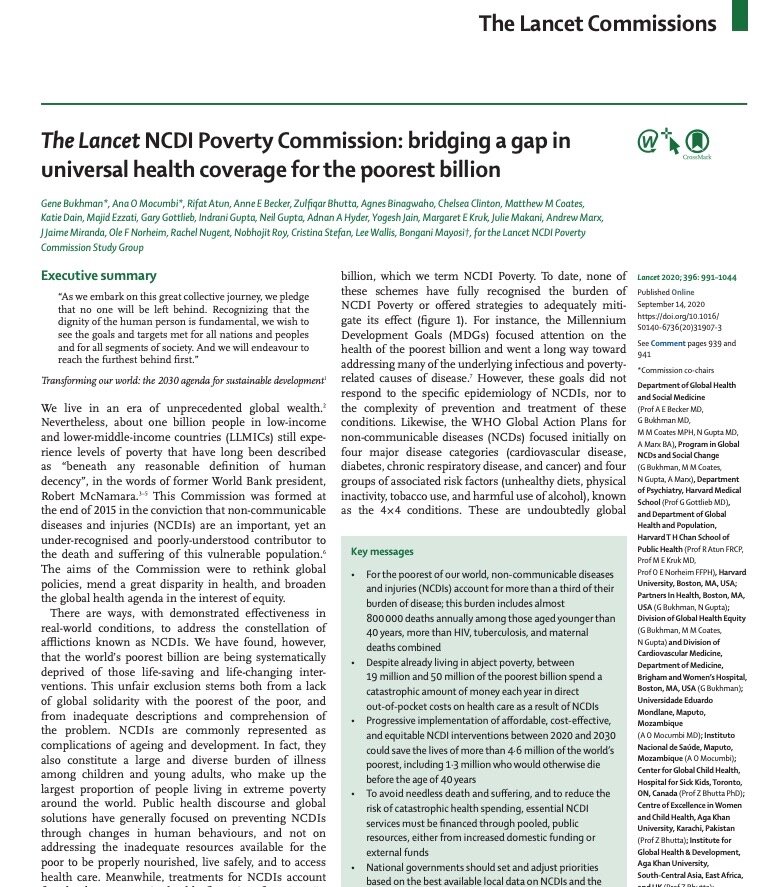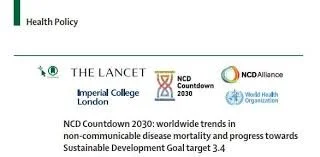Why the agenda of noncommunicable diseases and injuries needs to be expanded?
Dr. Nabeel Akram
There is a treacherous and complicated road between young Dipesh and the policymakers who are trying to close the investment gaps for non-communicable diseases and injuries (NCDIs). The recent Lancet NCDI Poverty Commission report challenges the World Health Organization’s 5x5 model for tackling NCDIs through a narrower lens using its ‘best buys’ approach. The 5X5 model refers to 5 diseases - cardiovascular, chronic respiratory, cancer, diabetes, mental and neurological, and 5 risk factors - unhealthy diet, tobacco use, harmful use of alcohol, physical inactivity, and air pollution. The Lancet Commission claims that the model does not take into account the bottom billion poor, like Dipesh, around the world. The NCDI agenda has to be reframed to encompass those who could potentially and alarmingly be left out, as a matter of justice and equity. What the Lancet Commission, WHO, researchers, and the public health specialists in global health are striving to accomplish for Dipesh can possibly take too long for him to get his heart valves fixed in Kathmandu. The operation to treat his heart valves will cost $500 plus expenses under the Government of Nepal's health scheme. It is just too much for the family despite the subsidized scheme. It could also be too late unless the resources are prioritized for universal health care, including the optimum investments for NCDIs within it.
Dipesh Rai is a 17-year-old boy living in Central Nepal, about 5 hours from Kathmandu. This fine looking young boy studies in grade 10 and aspires to learn Japanese. He wants to go to Japan, and make a living that can help his family recover from the aftermath of the 2015 earthquake in which Dipesh's house crumbled, and his father lost his job and livelihood. Today, his parents toil on a borrowed land and hardly make both ends meet to survive, along with their 3 children. They do not have enough resources to make a decision about raising funds for Dipesh's operation. Already they have been to Kathmandu several times with Dipesh to seek medical help and just going back and forth has cost them about $150. Dipsesh has been diagnosed with Rheumatic Heart Disease for three years now.
Rheumatic Heart Disease is caused by rheumatic fever, an inflammatory disease affecting the heart, joints, skin, or brain, which strikes typically between the ages of 5 and 15. This disease usually results from untreated or under-treated streptococcal infection.
I, myself, have been to the Central Region in Nepal in 2015 when the earthquake hit. I was there to support our team working on projects related to maternal and child health. I also wanted to see how our project and staff can contribute to the health system recovery post-earthquake. I have met families like those of Dipesh in that area. This natural calamity has been devastating for the families who lost their houses, land, and livelihood as the earth shook mercilessly. The scars it left would take years to heal and it pushed countless families into poverty and economic turmoil. It wasn't just the houses that the earthquake brought down. The trembler also destroyed the system that communities built over several decades including schools. Hence these deadly tremors brought down the future of a generation with it. Although, of course, I did not meet Dipesh or his family during my visit, I wonder now that he must be somewhere around there, after the earthquake, as a 12-year-old kid. He would be unsure of what just happened and why everything crashed around him. He would be oblivious to the fact that this broken health system in his vicinity will be unable to take care of him when he will contrive a streptococcal infection. An infection that could have been treated. But since it did not get proper attention from a devastated system, it most likely became the cause of developing a rheumatic fever in the case of Dipesh. He wouldn’t know at that time that it would permanently damage his heart valves over the next 5 years, and rendering him not to be able to be the pillar of his family that his parents hoped he would be as he grows older. Dipesh will no more be as productive for his family as everyone wished he could be, due to the illness that could have been avoided or treated later on, if the family could afford it. All of this could be avoided in one way or the other.
Dipesh is not alone. There is 14-year-old Sheila Chipenge in Malawi with Type 1 Diabetes, Fortuna Messaye (14 years) with Leukemia, Enoch Maloya (28 years) with psychosis in Malawi, and several others around the world who suffer from NCDIs that can either be prevented or treated. The loss of productivity can be reversed. All these young people can live a happier life if the NCDIs are prioritized in the health system and invested upon correspondingly to their burden of disease.
“Rheumatic Heart Disease is caused by rheumatic fever, an inflammatory disease affecting the heart, joints, skin, or brain, which strikes typically between the ages of 5 and 15. This disease usually results from untreated or under-treated streptococcal infection.”
For the poorest of the world, NCDIs account for more than a third of their burden of disease. This burden includes about 800,000 deaths annually among those aged younger than 40 years. This accounts for more than the burden of tuberculosis, HIV, and maternal deaths combined.
WHO recommends best buys for the prevention of noncommunicable diseases. It is important that the best buys are seen in the context of the country and the communities within it.The interventions considered as 'best buys' in one country can be either a 'wasted buy' in another (not having a similar impact than in other context or cultures) or at least be 'contestable buy’ (not having sufficient evidence to be impactful). Thus, Wanrudee Isaranuwatchai and colleagues argue in their British Medical Journal article that the best buys evaluated in one setting may not be as cost-effective in another. They further add that the evaluation of context is essential to ensure resources are best deployed towards universal health coverage.
Another report by the University of Victoria and the US Chamber of Commerce suggests that beyond the human rights arguments in favor of spending money on health, there are very sound economic reasons for doing so, which leads to higher overall economic growth and development. NCDs have a high economic cost. The study demonstrates that a $1 spent on cardiovascular diseases could provide a gain of $20 in economic and social benefits, while it could reap a higher return on investing a $1 on common mental illnesses with a $22 return in the same period.
There are heavy costs on businesses, governments, and individuals associated with NCDIs, which threaten much greater costs in the future. These affect both absenteeism that implies that people may be sick and absent from work, and presenteeism that points to the situations in which people are present at work but are not able to perform at full capacity due to illness. In both cases, there is an unsurmountable loss of productivity on a large scale.
It is imperative to review the investments in health and make adjustments for closing the resource gaps for noncommunicable diseases in the broader context of universal health coverage. Leveraging private sector resources is extremely essential in this regard and logical in various market contexts. The NCDI agenda has to be reframed to include justice and equity as critical factors in making these investment decisions.






